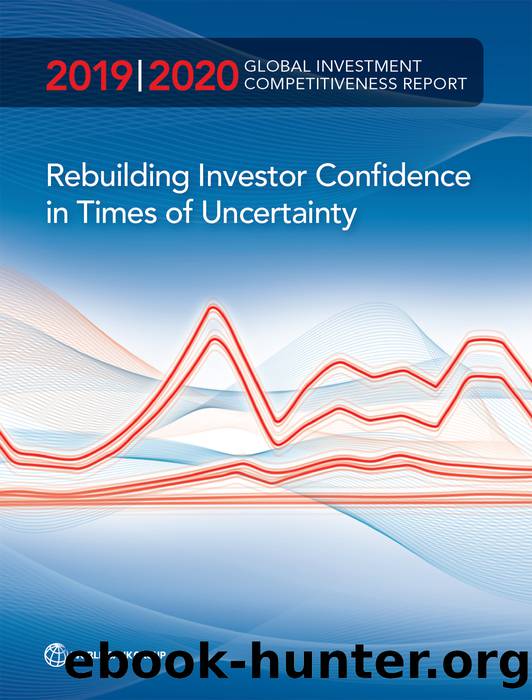Global Investment Competitiveness Report 20192020: Rebuilding Investor Confidence in Times of Uncertainty by The World Bank Group

Author:The World Bank Group
Language: eng
Format: epub
The Vertical Spillover Effects of FDI Are Mixed
When controlling for FDIâs direct effects, the results in other sectors (vertical labor market spillovers) are less conclusive. Findings are mixed across the three countries. The results from the second-stage IV (specifications in annex 3B, equation [3B.2]) are presented in annex 3C, table 3C.7. These present sector-region coefficients that interact FDI output share with intensity of a vertical sectorâs engagement with FDI. The magnitude can be hard to interpret. To aid interpretation, this table also includes the population-weighted average effects from each regression.
Ethiopia. No significant effect is found on either backward or forward linkages. This could indicate that relatively few domestic firms are currently supplying MNEs in Ethiopia. Another possibility is that the overall manufacturing sector is too small for any statistically significant results to appear.
Vietnam. The FDI backward link appears to be the most important channel. When FDI in upstream (selling) sectors increases, wages go up in the services sector (+5 percent), and formal employment in both manufacturing and services increases (+4.2 percent and +1.7 percent, respectively). Both types of increase may be the result of productivity increases linked to labor market benefits from accessing cheaper or higher-quality inputs (such as MNE producers of intermediate inputs, or in business services).
Turkey. The effect of FDIâs forward linkages is negative in manufacturing and has no effect on services. Increased FDI in downstream (buying) sectors is associated with a reduction in both formal manufacturing employment (â5 percent) and wages (â36 percent).14 One potential explanation is that MNEs are switching from domestic to foreign suppliers of intermediate inputs, prompting a decline in domestic production, labor demand, and wages of sectors with forward links to FDI. Such a finding would warrant additional analysis to better understand potential constraints between MNEs and domestic suppliers.
Download
This site does not store any files on its server. We only index and link to content provided by other sites. Please contact the content providers to delete copyright contents if any and email us, we'll remove relevant links or contents immediately.
The Brazilian Economy since the Great Financial Crisis of 20072008 by Philip Arestis Carolina Troncoso Baltar & Daniela Magalhães Prates(121319)
International Integration of the Brazilian Economy by Elias C. Grivoyannis(91250)
The Art of Coaching by Elena Aguilar(52948)
Flexible Working by Dale Gemma;(23254)
How to Stop Living Paycheck to Paycheck by Avery Breyer(19638)
The Acquirer's Multiple: How the Billionaire Contrarians of Deep Value Beat the Market by Tobias Carlisle(12241)
Thinking, Fast and Slow by Kahneman Daniel(12079)
The Radium Girls by Kate Moore(11921)
The Art of Thinking Clearly by Rolf Dobelli(10223)
Hit Refresh by Satya Nadella(9039)
The Compound Effect by Darren Hardy(8810)
Tools of Titans by Timothy Ferriss(8218)
Atomic Habits: Tiny Changes, Remarkable Results by James Clear(8186)
Turbulence by E. J. Noyes(7936)
A Court of Wings and Ruin by Sarah J. Maas(7652)
Change Your Questions, Change Your Life by Marilee Adams(7635)
Nudge - Improving Decisions about Health, Wealth, and Happiness by Thaler Sunstein(7615)
How to Be a Bawse: A Guide to Conquering Life by Lilly Singh(7393)
Win Bigly by Scott Adams(7094)
